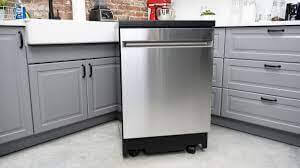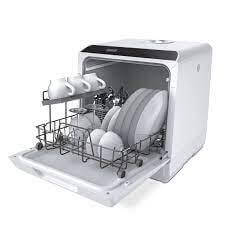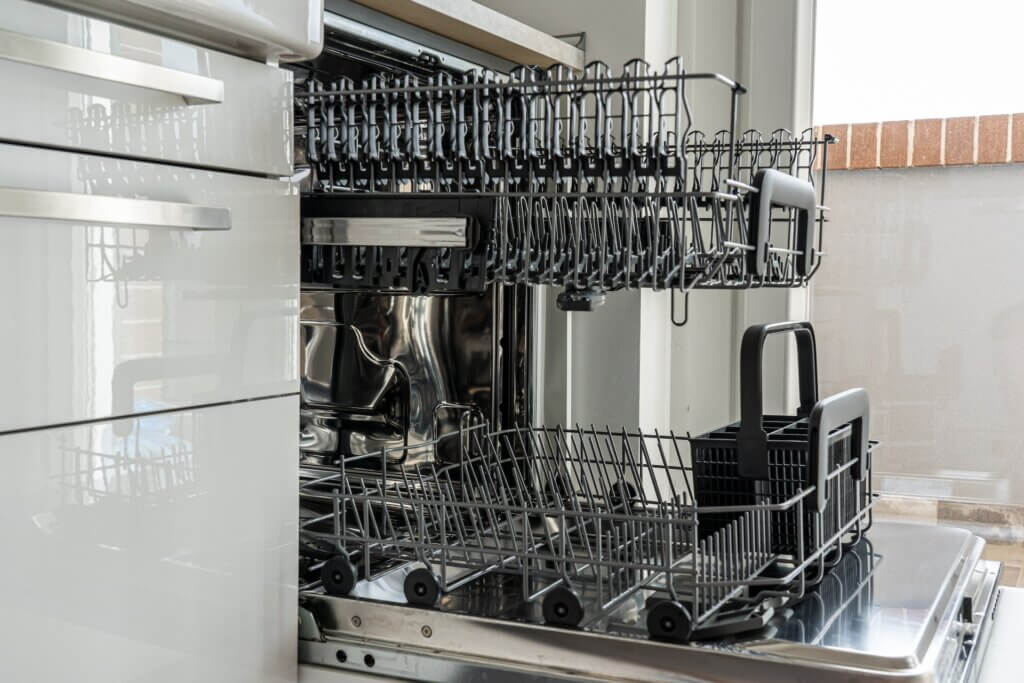
- Overview
- Evolution of dishwashers over the years
- Factors to Consider Before Buying a Dishwasher
- Types of Dishwashers
- “Place Settings”? What does that mean?
- Different “Place Settings” configurations for dishwashers in India
- Dishwasher Features and Technologies
- Energy Efficiency and Sustainability
- Maintenance and Durability
- Installation and Space Requirements
- Troubleshooting Common Dishwasher Issues
- Popular Brands in India
- Summary
- FAQs
Overview
Are you looking for a new dishwasher in the market? Look no further! The comprehensive dishwasher buying guide is here to assist you in making an informed judgment and finding the perfect one for your needs.
Having a dishwasher at home can significantly simplify dishwashing, allowing you to spend more time with your loved ones or focus on other household chores. It frees you from the boring and time-consuming task of manually washing each dish, utensil, and glass, leaving you with sparkling clean results and a more organised kitchen.
Evolution of dishwashers over the years
Dishwashers have come a long way since their inception. From their humble beginnings as noisy and inefficient machines to the sleek and sophisticated models we have today, the evolution of dishwashers has been remarkable.
Manufacturers have constantly refined and improved their designs, incorporating advanced technologies to enhance cleaning performance, energy efficiency, and convenience for the user.
Factors to Consider Before Buying a Dishwasher
Budget considerations
When buying a dishwasher, it is essential to establish a budget that aligns with your financial capabilities. Dishwashers come in a wide range of prices, and setting a budget will help you narrow down your options and make a more informed decision. Consider factors such as brand reputation, durability, and long-term energy and water consumption savings.
Dishwasher size and capacity
Determining the right dishwasher size and capacity for your household needs is crucial. Consider the number of people in your household and the average number of dishes and utensils you typically use in a meal.
Opting for a dishwasher with adjustable racks and flexible loading options can also be beneficial in accommodating various sizes of cookware and dishware.
Energy efficiency ratings and cost-saving options
Energy efficiency is an essential factor to consider when purchasing a dishwasher. Look for models with high Energy Star ratings that consume less electricity and water, resulting in significant cost savings over time.
Additionally, some dishwashers offer features like delay start options or eco-friendly cycles that further optimise energy usage.
Noise levels and soundproofing technology
Noisy dishwashers can be disruptive, especially in open-plan kitchens or if you prefer a quiet environment. Look for dishwashers equipped with soundproofing technology that minimises noise levels during operation.
Quiet dishwashers typically have specialised insulation, anti-vibration features, and quiet motors, ensuring a peaceful, undisturbed kitchen experience.
Cleaning and drying performance
The primary objective of a dishwasher is to thoroughly clean and dry your dishes. Consider dishwashers with multiple wash cycles and programs tailored to different loads. Look for features like pre-soak, heavy-duty, or delicate cycles to address specific cleaning needs.
Similarly, prioritise dishwashers with efficient drying capabilities, such as heated or condensation drying, to prevent water spots and ensure your dishes come out dry and ready to use.
Types of Dishwashers
There are basically 3 types of dishwashers available in the market:
Built-in Dishwashers

What are Built-in Dishwashers?
Built-in dishwashers are kitchen appliances designed to be permanently installed beneath your counter top, seamlessly integrating into your kitchen cabinets. They offer a sleek and cohesive look while efficiently cleaning and drying your dishes, making them a convenient and space-saving addition to modern kitchens.
A. Standard Built-in Dishwashers
Standard built-in dishwashers are designed to seamlessly integrate into your kitchen cabinetry. They are typically 24 inches wide, offering ample space for larger households or families frequently entertaining guests. These dishwashers provide a sleek and cohesive look to your kitchen while giving a powerful cleaning performance.
B. Slimline Built-in Dishwashers
Slimline built-in dishwashers are a practical choice for kitchens with limited space or smaller households. These dishwashers are typically 18 inches wide, ideal for compact kitchens or apartments. Despite their smaller size, they still offer efficient cleaning and drying capabilities, catering to the needs of individuals or small families.
Portable Dishwashers

What are Portable Dishwashers?
Portable dishwashers offer flexibility as they can be moved around your kitchen or taken with you if you relocate. These freestanding units have wheels for easy mobility and can be connected to a faucet or directly to the plumbing. They are available in various sizes and offer similar cleaning performance as built-in dishwashers.
Countertop Dishwashers

What are Countertop Dishwashers?
Countertop dishwashers are compact and sit on your countertop, requiring minimal installation. They are an excellent option for limited space, such as small kitchens or RVs. Though smaller capacities, countertop dishwashers still provide effective cleaning and are ideal for individuals or couples.
“Place Settings”? What does that mean?
When a dishwasher’s capacity is described in terms of “place settings,” it means the maximum number of complete sets of dishes and utensils that can be loaded into the dishwasher for a single wash cycle. This measurement helps consumers understand how many dishes and utensils the dishwasher can handle at once, making it easier to determine if the dishwasher’s capacity aligns with their household’s needs.
Each place setting typically consists of specific dishes and utensils one uses during a meal. Here’s what a standard place setting includes:
- Dinner Plate: The main plate used for serving the main course.
- Salad/Dessert Plate: A smaller plate for salads, appetisers, or desserts.
- Soup Bowl: A bowl used for serving soups or stews.
- Glass: A drinking glass for beverages like water or juice.
- Teacup with Saucer: A cup and saucer combination for serving tea or coffee.
- Fork: An eating utensil with prongs used for picking up food.
- Knife: A utensil with a blade used for cutting food.
- Spoon: An eating utensil with a rounded bowl for liquids or solids.
Different “Place Settings” configurations for dishwashers in India
Here are the standard “place settings” configurations available:

Dishwasher Features and Technologies
Wash cycles and programs
Modern dishwashers offer various wash cycles and programs to cater to different loads. Look for dishwashers with regular, heavy, delicate, quick, eco-friendly, or sanitising cycles. These programs ensure your dishes are effectively cleaned based on their specific requirements.
Adjustable racks and loading options
Adjustable racks in your dishwasher allow you to customise the interior layout to accommodate various sizes and shapes of dishes, pots, and pans. Look for dishwashers with flexible loading options, such as fold-down tines, removable utensil baskets, and adjustable upper racks. These features make it easier to fit larger cookware or create extra space for taller glasses.
Third rack and specialised compartments
Some dishwashers come with a third rack, providing additional capacity and versatility. The third rack is typically designed for cutlery or small items, freeing up space in the lower shelves for larger dishes. Look for models with specialised compartments or holders for things like wine glasses or fragile utensils, ensuring their safety during washing.
Soil sensors and auto programs
Dishwashers equipped with soil sensors can automatically adjust the wash cycle duration and water consumption based on the level of dirtiness detected. This feature optimises cleaning performance while saving water and energy. Consider dishwashers with auto programs that detect and adjust the settings accordingly, making your dishwashing experience more convenient and efficient.
Wi-Fi connectivity and smart features
In an increasingly connected world, some dishwashers have Wi-Fi connectivity and smart features. These allow you to control your dishwasher remotely through a smartphone app or integrate it with other smart home devices. You can turn on or monitor the progress of your dishwasher, receive notifications when the cycle is complete, or even download custom wash cycles for specific dishes.
Water softener and hard water compatibility
If you live in an area with hard water, a dishwasher with a water softener can help prevent limescale buildup on your dishes and the dishwasher’s interior. Look for models with this feature or those specifically designed to handle hard water, ensuring that your dishes come out spotless even in challenging water conditions.
Energy Efficiency and Sustainability
Energy Star ratings and requirements
Energy Star ratings are a reliable indicator of a dishwasher’s energy efficiency. Look for dishwashers with the Energy Star label, as they meet strict guidelines set by the Bureau of Energy Efficiency, an Indian governmental agency under the Ministry of Power.
These dishwashers use less energy and water, reducing your environmental footprint and saving you money on utility bills.
Water-saving features and technologies
Conserving water is an essential aspect of responsible and sustainable living. Dishwashers with water-saving features, such as sensors adjusting water usage based on load size or low-water consumption cycles, can help minimise water wastage.
Some models offer half-load washes or eco-friendly cycles, further optimising water usage without compromising cleaning performance.
Environmental impact considerations
When purchasing a dishwasher, considering the environmental impact of the materials used in its construction is worth considering. Opt for dishwashers made from eco-friendly materials or ones that use recycled components.
Additionally, consider the manufacturer’s commitment to sustainability and its efforts to reduce waste, carbon emissions, and energy consumption throughout production.
Maintenance and Durability
Filter Cleaning & Maintenance
Proper maintenance and cleaning of your dishwasher’s filter are essential for optimal performance and prolonging lifespan. Look for dishwashers with easily accessible and removable filters that can be cleaned regularly to prevent clogs and ensure efficient water drainage.
Regular maintenance will also help avoid unpleasant odours caused by trapped dirt and debris.
Stainless Steel vs. Plastic Tubs
Regarding durability, dishwashers with stainless steel tubs are generally considered the best option. Stainless steel tubs are more resistant to staining, odours, and cracking than plastic tubs. They also retain heat better, improving drying performance.
Though plastic tubs are more budget-friendly, investing in a dishwasher with a stainless steel tub often pays off in terms of longevity and overall performance.
Self-cleaning Features
Some dishwashers come with self-cleaning features that help remove food residues and prevent the buildup of bacteria and odours. Look for steam or intensive cleaning models specifically designed to clean the dishwasher’s interior. These features contribute to the maintenance and durability of your dishwasher while ensuring hygienic washing results.

Warranty and Long-term Reliability
When making a significant investment in a dishwasher, it is crucial to consider the warranty provided by the manufacturer. Choose a dishwasher from a reputable brand with a comprehensive warranty covering parts, labour, and potential defects or malfunctions.
Additionally, read customer reviews and consider the long-term reliability of the brand and model you want to purchase.
Installation and Space Requirements
Integrating with Existing Kitchen Layout
Before purchasing a dishwasher:
- Assess your existing kitchen layout and determine the best location for installation.
- Consider factors such as proximity to plumbing connections, cabinet space availability, and the convenience of accessing the dishwasher.
- Ensure the dishwasher model is compatible with your kitchen’s aesthetics and fits seamlessly with the cabinetry.
Proper Electrical & Plumbing Considerations
They are crucial to ensure safety and ease of use when installing a dishwasher. Consult a professional if you need clarification on the electrical requirements or need to modify your plumbing connections. The dishwasher should be adequately grounded and connected to a dedicated circuit, with the necessary plumbing connections and drainage system.
Ventilation Requirements
Dishwashers require proper ventilation to prevent moisture buildup and potential mould growth. It is essential to provide adequate airflow around the dishwasher, especially if it is built-in. Ensure that the chosen installation location allows for proper ventilation and that any existing ventilation systems in your kitchen are not obstructed or compromised.
Troubleshooting Common Dishwasher Issues
Identifying and Fixing Drainage Problems
Drainage issues are common dishwasher problems resulting from clogs or blockages in the drain hose, filter, or garbage disposal. Check these components for any obstructions and clean them thoroughly. Additionally, ensure that the drain hose is connected correctly and not kinked.
If the problem persists, consult the dishwasher’s troubleshooting guide or contact a professional.
Resolving Cleaning and Drying Performance issues
If your dishes are not coming out as clean or dry as desired, use appropriate detergents, load the dishwasher correctly, and utilise the proper wash cycles for the load. Examine the spray arms for blockages and clean them if necessary.
If cleaning and drying performance issues persist, consider contacting the manufacturer or a professional for further assistance.

Dealing with Dishwasher Leaks
Leaks from dishwashers can occur due to faulty door seals, loose connections, or damaged hoses. Inspect the door gasket for any signs of wear or damage and replace it if necessary. Tighten any loose connections and check the hoses for cracks or leaks.
If the leak persists, it is advisable to seek professional help to prevent further damage and water wastage.
Popular Brands in India
Although, the dishwashers have not yet, became a staple kitchen appliance in the Indian kitchen. But, the popularity and necessity of the product is on the rise. There are few dishwasher brands that have made their place and continue to provide a quality experience to the Indian customers – like – Bosch, Siemens, IFB, LG, Samsung.
For better deals and promotional offers, you can visit online stores as well:
Summary
In conclusion, buying a dishwasher is a significant investment that can simplify your kitchen routine, save time, and ensure clean and sanitised dishes.
Remember to choose a reputable brand with excellent customer reviews and ensure that the selected dishwasher aligns with your lifestyle and sustainability goals.
You can make an informed decision that meets your needs and preferences by considering budget, size and capacity, energy efficiency, maintenance requirements, and installation considerations.
Please read other interesting posts too:
This blog site has interesting reviews and buying guides of other Kitchen Appliances like Coffee Machines, Wet Grinders, Electric Kettles, Mixer Grinders, Food Processors , Oven Toaster Grills, Dishwashers. You can always visit them for an interesting read.
FAQs
What should be the minimum capacity of a dishwasher for a family of four?
A dishwasher with a minimum capacity of 12 to 14 place settings is generally recommended for a family of four. This capacity can accommodate the dishes, utensils, and glasses typically used in a single meal for a family of four.
How long does a dishwasher usually last?
The lifespan of a dishwasher varies depending on various factors such as usage, maintenance, and build quality. On average, a well-maintained dishwasher can last between 8 to 12 years. However, some high-quality models can last even longer with proper care.
Can I use regular dish soap in a dishwasher?
No, regular dish soap should not be used in a dishwasher. Dishwashers require specially formulated dishwasher detergents designed to produce less foam and effectively clean dishes in the high-temperature environment of the dishwasher. Using regular dish soap can result in excessive sudsing, poor cleaning performance, and potential damage to the dishwasher.
Are dishwashers safe for delicate glassware?
Yes, dishwashers can be safe for delicate glassware if used correctly. Look for dishwashers with delicate or glassware-specific wash cycles, lower water temperatures, and gentler spray patterns. Additionally, ensure that you load delicate glassware securely with ample spacing to minimise the risk of breakage during the wash cycle.
How can I prevent spotting and streaking on my dishes?
Use a high-quality dishwasher detergent with rinse aid capabilities to prevent spotting and streaking on your dishes. Rinse aid helps to prevent water droplets from clinging to the dishes, resulting in improved drying and reduced spotting. Proper loading techniques, such as avoiding overcrowding and ensuring adequate spacing between items, can contribute to better drying and minimising spotting.



Be the first to comment